General Electric, Part III - The U-935A
by Ed Sewall
Reprinted from "Crown Jewels of the Wire", June 2001, page 11
This article concludes my three-part series on the early General Electric
(GE) dry process insulators. This article will focus on the last of these
insulators GE is thought to have made, the U-935A. As with the two previous
articles, I will attempt to document all that is known to date about the
installations where this relatively rare insulator was used. From the research I
have conducted on the U-701 (see Crown Jewels of the Wire Jan. 1988), U-744 (see
Crown Jewels of the Wire Nov. 1988) and the unmarked U-935A, the U-935A appears
to have been the last dry process insulator that General Electric manufactured
for its early transmission projects, primarily in the western United States. As
will be described in the following information, the unmarked U-935A appears to
have been manufactured between 1896 and early 1897.
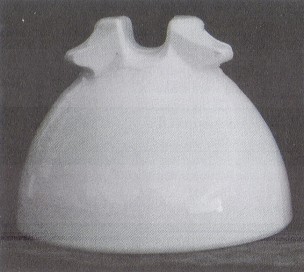
U-935A dry process General Electric insulator
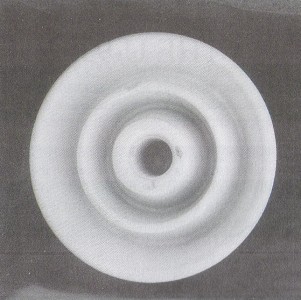
Bottom view of U-935A dry process General Electric insulator.
The U-935A is a scarce insulator that has been found both marked (by
Imperial) and un-marked (by GE). It is a unique porcelain style because of the two tie wire projections on each side of the crown. Obviously this was a
fragile design that was destined to be short-lived. The unmarked specimens are
all dry-process insulators and, as will be described, can be attributed with
near certainty to manufacture by GE. The marked specimens have an incuse date
stamp that ranges between May and July of 1897. These insulators are wet-process
units and were manufactured by Imperial for GE as replacements for the inferior
dry process GE units on various lines in the Salt Lake City, Utah area.
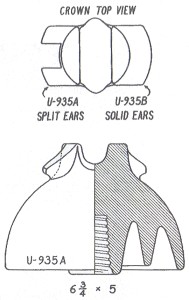
Elton
Gish has briefly documented the history of the use of the NN U-935A insulator in
his Porcelain Insulator News column as well as in his book, Fred M. Locke: A
Biography (1994). I intend to expand on the information Elton has uncovered for
those interested in more of the details.

Unmarked GE U-935A on left and a U-935A Imperial on right. Note
straighter
lines of the ears on the Imperial as compared to the curving
ears on the GE.
Mold line under ears is also evident on the GE.
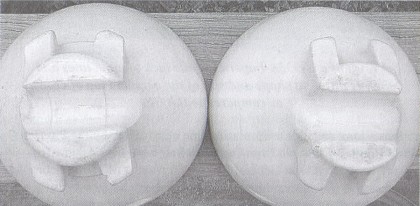
Left GE U-935A, right Imperial U-935A
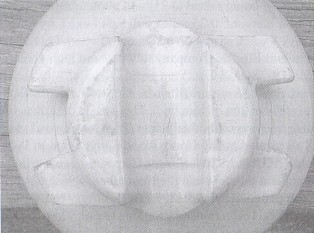
Crown of an unmarked GE U-935A. Note distinct mold
lines in cable groove and
below tie wire ears.
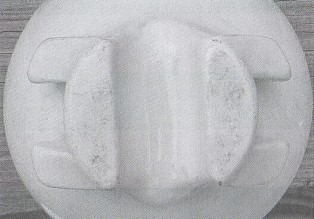
Crown of a U-935A Imperial. Note lack of mold lines
and slightly different
shape and size of the ears and
top of crown as compared to the GE.
An article in The Electrical World,
dated September 26, 1896, describes a long distance transmission line constructed by the Pioneer
Electric Company that ran from Ogden to Salt Lake City, Utah. This company
contracted with General Electric in August of 1896 to complete a three-phase, 36
mile transmission line from a dam and power house being constructed on the Ogden
River. The plant and transmission line were anticipated to be operational in
November of 1896. The transmission line is described as two (2) three-phase
lines to be energized at 15kv, with the ability of the voltage being raised to
25kv to allow transmission to the mining regions of Mercur, 30-35 miles past
Salt Lake City. The line "will pass over six No.1 wires strung on
insulators of special porcelain developed by the General Electric Company to
withstand high potentials." (Electrical World 9-26-1896).
Another article
in Electrical World & Engineer dated March 30, 1901, reveals further
information on this line. This article describes the Pioneer plant in Ogden as
well as two other plants (Big Cottonwood plant and Utah Station) all located
in Big Cottonwood Canyon that in 1901, were under ownership of Utah Light &
Power Company. This article reveals that the Pioneer plant did not meet the
November 1896 start up date and was actually completed in July of 1897. At this
time the transmission line was operating at 23kv. The transmission line to Salt
Lake City again was described as No.1 copper wire on porcelain insulators, all
installed by General Electric.
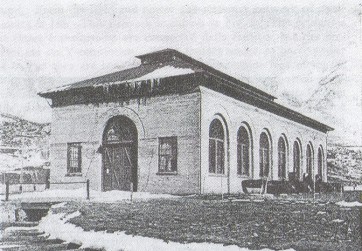
Ogden Power House in 1901.
The second installation described is the Big
Cottonwood Canyon hydroelectric plant located 14 miles southeast of Salt Lake
City. A third plant known as the "Utah Station" was constructed just below the
tailrace of the Big Cottonwood plant. This plant was a Westinghouse installation
and was constructed specifically to provide power to the Salt Lake City
Railroad.
As with the Ogden plant and transmission line, the Big Cottonwood
plant and line was also described in Electrical World & Engineer (March 30,
1901) as an entire General Electric installation and was the earliest of these
two systems completed in 1896. The transmission line to Salt Lake City consisted
of two, three-phase circuits of No. 2 wire on porcelain insulators. The
insulators on this line were described as "among the first high-tension
insulators turned out and were made by the dry process". As described in my
previous General Electric U-744 article (see Crown Jewels of the Wire Nov.
1998), this line definitely used the General Electric U-744 dry process
insulators. Only the U-744's have been found on or along the Big Cottonwood
line, no U-935A specimens have been found on this line.
The insulators on the
Ogden and Utah lines were both described as being made by Imperial Porcelain
Works and tested at 50kv. This conflicts with the earlier information in the
Sept 1896 Electrical World that indicates the intended use of an insulator
specially designed by GE for the Ogden line. The 1896 Electrical World appears
to be more accurate than the Electrical World & Engineer 1901 article, as
General Electric NN U-935A's have been found on the Ogden line. It appears that
the Imperials they referred to in the 1901 article were really the replacements
for the original General Electric NN U-935A's. The 1901 Electrical World &
Engineer article states that they had no problems on either the Ogden or the Utah
plant line in regards to the insulators. I inspected the white porcelain
insulators in two photographs in this article with a hand lens. (See black
indicator arrow with photo in previous page.) Although the insulators definitely
look to be either a U-935A or U-935B, they cannot be positively identified as
either due to the small size of the photo.
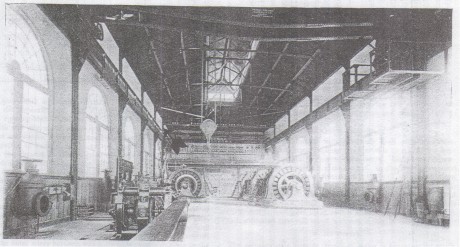
Medium Image (104 Kb)
Large Image (287 Kb)
Interior of Ogden Power House in 1901. Note row of at least 19 white
porcelain insulators
near the ceiling at far end of the building. These are
probably U-935A General Electric insulators.
In the November 1978 issue of Crown
Jewels of the Wire, Doug Bushnell reported finding the unmarked dry process
U-935A's in and around the ghost town of Mercur, Utah. Other than several
unmarked U-935A's recovered from the Ogden line and several other isolated finds
outside of Utah, I believe the insulators Doug recovered represent nearly all of
the unmarked dry process U-935A specimens in the hobby today. His Crown Jewels
of the Wire story states that the transmission line came from Provo. However, I
believe the line he was searching was really the terminus of the Ogden line
previously described. In addition to the unmarked dry process U-935A's, Doug
also found wet process Imperial U-935A's with March 1897 dates as well as some
wet process Imperial U-935B's with date stamps from May and July of 1897.

Medium Image (44 Kb)
Large Image(126 Kb)
System of Utah Light and Power Company.
I
spoke with Doug in 1998, and he described the area of his hunt
in the 1960's was in the hills above the old mining town of Mercur. Doug
said at that time the town was a "hippie commune" and was
in near ruin. This area is now off limits to public access and owned by Kennicott Mining.
Doug said that he spent many days hunting the line over
several years and felt he removed pretty much all of the
whole or slightly damaged insulators on the line. Over the years Doug used these as traders to build his collection.
Doug
also found some unmarked dry process U-935A's near Cedar Forks, Utah, on a line
that came from Provo through Jordon Meadows and into Bingham. I have no
information on this line. He also mentioned that a lineman brought down an
unmarked U-935A from an old line that ran up Weber Canyon to Echo Junction, then
on to Evanston, Wyoming. As with the Cedar Forks find, he didn't know any
historical details of this line.
The date stamps on the Imperials Doug found
leads to the conclusion that the U-935A Imperials were replacements for the dry
process GE units initially installed. As previously described, this line was
completed in July of 1897. It is also possible that some Imperials were used on
the original installation to supplement the GE units. GE may have decided to
step back from the high voltage insulator business at this time until they could
get a decent wet process insulator design of their own.
In addition to Doug
Bushnell's find, Vic Sumner reported finding an unmarked U-935A GE in Yucaipa,
California in the 1950's. According to Vic, he observed a line crew changing
over an old line close to the old Mill Creek station located on a branch of the
Santa Ana River. The pole line consisted of 70-90 foot tall poles with three
crossarms. On one side of the pole, a single insulator on each arm supported the
conductors. Vic said that the U-935A's he observed on the line were just one of
several types of insulators in use. This line was a branch line off the Redlands
Electric Light & Power Company line about 2 miles from the Mill Creek
station. The insulators were found along a street about a 1/2 mile from the
station. According to Hammond (1941), General Electric installed this country's
first commercial polyphase system at Redlands in 1893. The plant commenced
operations on November 7, 1893, and was driven by one of the first of Lester
Pelton's impulse waterwheels. The first customer of the commercial line was the
Union Ice Company in Meltone, and many more were to follow.
Although there is no
mention of the insulators used on this line, it would be expected that General
Electric would use their own insulators on these early installations as they
became available. It is probable that the U-935A that Vic found was placed in
service sometime in 1896, replacing an earlier insulators such as the CD 178
"Santa Ana" that was first used on the line.
Larry Furo found a whole
unmarked U-935A in the Keweenaw Peninsula of upper Michigan in the copper mining
district. According to Larry, his specimen came off an old iron double
"H" frame tower that lead to a stone structure next to a mine hoist.
He also noted about six other broken specimens under the tower and one broken in
half still on a pin. Although I have not inspected the specimen, his description
of the mold lines and no date marking make it sound like a GE also.
ADDENDUM TO PREVIOUS GE ARTICLES
U-701
Apparently the U-701 that Jack Tod used for the drawing in the U# chart was
taken from a specimen owned by Larry Thomas of Oroville, California. According
to Larry the insulator was removed from a Great Western Power & Light line
in 1955-1960 about 50 miles south of Oroville. This matches up with where the
Folsom line was. GWLP was purchased from PG&E in 1915-1920.
A U-701 was
also found in an antique store near Portland, Oregon, and could possibly come
from the early Willamette Falls Electric Company line that went into service in
1899. However, it is more likely it is a specimen that just made its way north
from the Folsom line in antique shops.
U-744
As brought to my attention by Rick Soller, the U-744 used on the Telluride
line was detailed in the Ralph Mershon biography. This book positively
identifies the U-744 as being made by General Electric.
Dennis Hackthorne wrote
me a letter stating he found a U-744 in a junk shop in Redlands, California. It
is possible the U-744 was a replacement insulator in 1895 used sporadically on
the Redlands line for broken CD 178s.
 |
| U-744 |
U-935B |
| Photograph of a dry process GE U-744 next to a U-935B Imperial.
(From
Polyphase Apparatus and Systems, Maurice Oudin, 1900) |
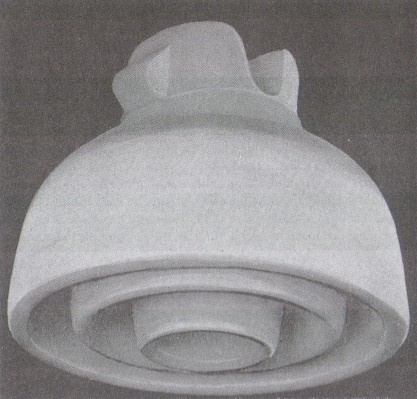
Photograph of a U-744 dry process GE insulator.
(From an article on the Niagara
line in Cassins, 1895 magazine.)
CONCLUSION
It is possible that the U-744 and even the U-935A could have been used on
several other of the early transmission projects that GE installed prior to
1897. General Electric had installed equipment for numerous local light and
power companies by the year 1894, so the possibilities of other installations
using at least some of these insulators is great.
The history of the General
Electric dry process units is unique in that they were an integral, and very
important part of some of the very first power transmission systems in this
country. Along with the Thomas produced dry process Fred Locke U-923C, the
General Electric produced U-701, U-744 and U-935A insulators were the earliest
porcelain high voltage designs ever used in this country. As such, these
insulators represent for porcelain insulator collectors, some of the most
desirable and historic specimens in the hobby.
References:
Cassiers Magazine, 1895.
Crown Jewels of the Wire, "The
General Electric Porcelain Company and the U-701", E. Sewall, Jan. 1978
Crown Jewels of the Wire, "The General Electric Part II, U-744 Company and
the U-701", E. Sewall, Nov. 1978
Fred M. Locke: A Biography, Gish, Elton
N., 1994.
Harnessing of Niagara, 1895
Maurice Oudin, Polyphase Apparatus and Systems, dated 1900
The Electrical World, September 26, 1996.
"High voltage
power transmission" by C.F. Scott in the Journal of the American Institute
of Electrical Engineers, June 30, 1898.
The Electrical World and Engineer, March
30, 1901.
Men and Volts, The Story of General Electric, Hammond, 1941
"Porcelain Insulator News", Crown Jewels of the Wire, Sept. 1994,
& January 1995.
| 